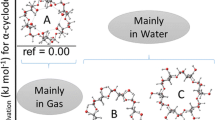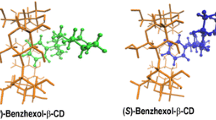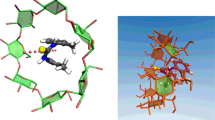Abstract
The conformation of a free β-cyclodextrin molecule optimized by the MNDO/PM3 quantum-chemical calculations has C7 symmetry. The “right” orientation of the interglucose hydrogen bonds in β-cyclodextrin, in which the 2-OH groups act as the proton donors and the O atoms of the nearby 3"-OH groups function as the proton acceptors, is advantageous for thermodynamic reasons. The ring of seven H bonds thus formed stabilizes the symmetrical form of β-cyclodextrin. The β-cyclodextrin head-to-head dimer has D 7 symmetry and consists of molecules whose 2-OH groups partcipate as proton donors in the formation of fourteen complementary intermolecular hydrogen bonds. The energy of H bonds in the β-cyclodextrin monomer and dimer was estimated to be 1.0--1.4 kcal mol–1. Of the two possible β-cyclodextrin dimers, the “head-to-tail” dimer is more thermodynamically stable. The thermodynamic preference of the right orientation of the inter-glucose H bonds in β-cyclodextrin was confirmed by the MP2/6-31G(d,p)//6-31G(d,p) ab initio calculations for maltose (α-glucodioside). The maltose molecule with inter-glucose H bonds of the type 2-OH→O(3")-H is more stable than the structure with the H-(2)O←H-O(3") orientation of H bonds with a difference of ∼2.7 kcal mol–1. According to the MNDO/PM3 method, the maltose structure with the right H bond orientation is more stable by ∼3.1 kcal mol–1.
Similar content being viewed by others
References
V. T. D'Souza and K. B. Lipkowitz, Cyclodextrins (Special Issue), Chem. Rev., 1998, 98, 1714.
K. Harata, Cyclodextrins (Special Issue), Chem. Rev., 1998, 98, 1803.
Cambridge Structural Database, University of Cambridge, UK, 2000.
C. Betzel, W. Saenger, B. E. Hingerty, and G. M. Brown, J. Am. Chem. Soc., 1984, 106, 7545.
V. Zabel, W. Saenger, and S. A. Mason, J. Am. Chem. Soc., 1986, 108, 3664.
T. Steiner, S. A. Mason, and W. Saenger, J. Am. Chem. Soc., 1991, 113, 5676.
B. E. Hingerty, C. Betzel, and W. Saenger, Am. Cryst. Assoc., Abstr. Papers (Winter), 1984, 12, 37.
I. N. Topchieva, E. I. Popova, F. A. Kalashnikov, I. G. Panova, V. G. Avakyan, and V. I. Gerasimov, Dokl. Akad. Nauk, 1997, 357, 648 [Dokl. Chem., 1997 (Engl. Transl.)].
K. B. Lipkowitz, Chem. Rev., 1998, 98, 1829.
K. B. Lipkowitz, J. Org. Chem., 1991, 56, 6357.
C. Margeritis and C. Sinistri, Z. Naturforsch., 1996, 51a, 950.
N. S. Bodor, M. J. Huang, and J. D. Watts, J. Pharm. Sci., 1995, 84, 330.
M. J. Huang, J. D. Watts, and N. Bodor, Int. J. Quant. Chem., 1997, 64, 711.
V. B. Luzhkov and C. A. Venanzi, J. Phys. Chem., 1995, 99, 2312.
X.-S. Li, L. Liu, Q.-Z. Guo, S. D. Chu, and Y.-C. Liu, Chem. Phys. Lett., 1999, 307, 117.
V. G. Avakyan, V. B. Nazarov, M. V. Alfimov, and A. A. Bagatur'yants, Izv. Akad. Nauk, Ser. Khim., 1999, 1857 [Russ. Chem. Bull., 1999, 48, 1833 (Engl. Transl.)].
J. J. P. Stewart, J. Comput. Chem., 1989, 10, 209.
M. W. Schmidt, K. K. Baldridge, J. A. Boatz, S. T. Elbert, M. S. Gordon, J. H. Jensen, N. Matsunaga, K. A. Nguen, S. Su, T. L. Windus, M. Dupius, and J. A. Montgomery, J. Comput. Chem., 1993, 14, 347.
J. W. Brown and B. D. Wladkowski, J. Am. Chem. Soc., 1996, 118, 1190.
M. E. Gress and G. A. Jeffrey, Acta Crystallogr., Sect. B, 1977, 33, 2490.
F. Takusagawa and R. A. Jacobson, Acta Crystallogr., Sect. B, 1978, 34, 213.
PC Model V. 7. Molecular Modeling Software, Serena Software, Box 3076, Bloomington, IN 47402-3076, USA.
S. Immel and F. W. Lichtenthaler, Liebigs Ann., 1995, 929.
F. W. Lichtenthaler and S. Immel, Liebigs Ann., 1996, 27.
R. L. VanEtten, J. F. Sebastian, G. A. Glowes, and M. L. Bender, J. Am. Chem. Soc., 1967, 89, 3253.
B. Casu, M. Reggiani, G. G. Gallo, and A. Vigevani, Tetrahedron, 1968, 23, 281.
L. A. Curtiss, D. J. Frurip, and M. Blander, J. Chem. Phys., 1979, 71, 2703.
J. A. Odutola and T. R. Dyke, J. Chem. Phys., 1980, 72, 5062.
K. A. Jebber, K. Zhang, C. J. Cassady, and A. Chung-Phillips, J. Am. Chem. Soc., 1996, 118, 10515.
Author information
Authors and Affiliations
Rights and permissions
About this article
Cite this article
Avakyan, V.G., Nazarov, V.B., Alfimov, M.V. et al. The role of intra- and intermolecular hydrogen bonds in the formation of β-cyclodextrin head-to-head and head-to-tail dimers. The results of ab initio and semiempirical quantum-chemical calculations. Russian Chemical Bulletin 50, 206–216 (2001). https://doi.org/10.1023/A:1009557729668
Issue Date:
DOI: https://doi.org/10.1023/A:1009557729668




